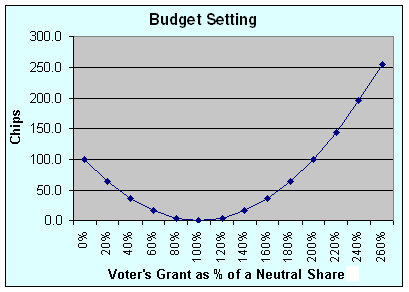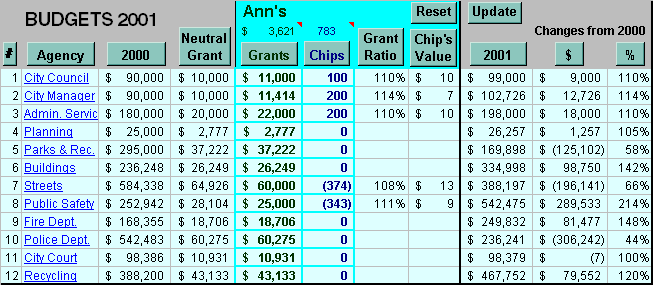|
Different uses for voting
need different types of voting. |
 |
Budget-Setting Points |
 |

|
A rep can influence 1 share of each agency budget, which adds up to 1 share of the total fund. For example, members of a nine-seat city council each allocate one-ninth of the council's money.
Because we are funding ongoing agencies, a ballot starts by giving 1 share to each agency. In our example, that is one-ninth of last year's budget. This is called a neutral grant because it does not raise or lower the agency's budget. How does this voting rule give a minority its fair share of power? The minimum grant a rep may give limits how much a group may hurt an agency. At the high end, the cost in political cards or influence points limits how much a group can raise its grants to an agency. If that cost in cards is not too high compared with the number of cards each rep receives, then a near majority can afford to give almost twice the neutral grant and its cost in cards. To let a smaller minority maintain an agency's funding, the minimum grant can be raised. (Increasing the number of cards for each rep might help because those cutting an agency are limited mostly by the minimum grant, while those raising it are limited by the number of cards needed to increase a grant.) (The table below shows how a rep's grant changes affect her card costs. It illustrates progressive costs to discourage dumping and freeriding.) Features of fair-share Budget-Setting Points (BSP)1. Each rep spends only her share of the budget -- a personal account that rewards efficient use and which clearly shows her priorities to her constituents, making her accountable. 2. The minimum grant is usually zero. (1 & 2. These two features ensure that a large minority can fund several agencies regardless of what the majority gives those agencies. But the danger of a rep dumping all her funds on a favorite necessitates an incentive to distribute funds. The rule therefore constrains reps by both their share of money and by their share of political influence.) 3. Each rep starts with a neutral ballot that gives each agency one share of its budget for last year: agency's current funding / voters. 4. Each rep also has only a limited number of political cards or influence points needed to push her grants away from neutral. No points are charged for a neutral grant. 5. There are equal charges for lowering as well as raising budgets. Voters pushing in either direction have no advantage over their opponents. 6. Card costs rise sharply if a rep drops her grant near zero. To zero out an agency is the budgetary complement of dumping funds on a favorite and not supporting the other public goods she uses. (An agency can be eliminated by simple majority vote, but that precedes the budget process.) 7. The cost schedule also soars as a grant nears double the neutral level. (Grants of 0% and 200% are the same distance from neutral, hence these steep increases satisfy point 5, symmetrical and unbiased costs.) So the practical upper limit for a grant is about 2.0 times the neutral grant. (6 & 7. These two features restrain reps from polarizing into those who give too much for B versus those who give B nothing at all.) Are these criteria necessary and sufficient to discourage exaggerated votes and empower minority reps? Incentive systems are only as good as the behavior they evoke. Since that varies from one setting to another, the system must adapt. The cost schedule below meets the seven criteria. It can cover a range of incentives from mild to severe depending on how many cards the reps start with.
The card cost is zero for a neutral grant (100%) and symmetrical to each side. There probably are several very good formulas for fair-share budget setting, just as there are for proportional representation. Experience will reveal which are best in particular settings. The networked ballot and tally software below use a square-root formula adapted from theoretical work by Hylland and Zeckhauser.
BallotsThere are three ways to take influence point ballots, depending on how many computers the voters have and how at ease they are working with precise numbers.1) The ideal method lets voters see and quickly react to each others' votes as they happen. That means having a computer for each voter and linking them together through a secure local network. 2) A less expensive method lets each vote take a turn at one of the computer voting booths 3) A paper ballot asks a voter to grade the agencies from A to Z with no ties allowed.
Each curve uses all of the voter's money and influence points. Voters don't need to worry about running out of money of cards. He does not need to free up money by lowering a budget before he can raise another budget. All three methods work best if the voters have [3] chances to look at the budgets and change their ballots. Councils can use local-network ballots that show the current budgets totaled from all reps. Click the pictures below to download a working ballot for Excel 5 or later. Budget_Set.zip is a 475K zip file with a tally sheet and 9 linked ballots. It can be expanded for more voters. The fact that reps are limited by both their share of money and by their share of political cards makes this rule a little hard to explain -- but it is easy to vote. The software lets you enter either money or cards and then calculates the other for you. You can enter the money you want to grant Agency B and let the software tell you the cost in political cards. Or you can enter the political price you're willing to pay and let the software tell you how much that adds to (or subtracts from) the budget. This program is simple compared to Movable Money Votes for funding projects. MMV software works hard to optimize the set of winners based on the grades voters give to proposals. VIP software, on the other hand, lets the each rep adjust her votes as she tries to optimize her results. | ||||||||||||||||||
In practice the columns for "2000", "Grant Ratio" and "%" might
be hidden. They are shown above to explain the calculations.
|
The next page will show the rule's incentives and distribution of power even more clearly by testing it with coalitions of various sizes. It strongly motivates reps to build large coalitions.
|

|
|






 Accurate Democracy
Accurate Democracy 







